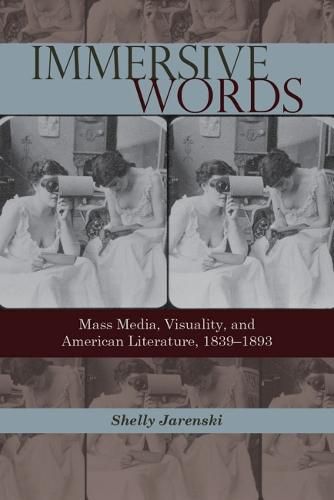Readings Newsletter
Become a Readings Member to make your shopping experience even easier.
Sign in or sign up for free!
You’re not far away from qualifying for FREE standard shipping within Australia
You’ve qualified for FREE standard shipping within Australia
The cart is loading…






Immersive Words traces how innovations in visual practices and aesthetics in the nineteenth century changed the aesthetics of American literature with profound consequences for America’s evolving national identity.
In Immersive Words, Michelle Jarenski demonstrates that the contempo rary challenge that visual images and virtual environments in cinema and photography, on the web, and in video games pose to reading and writing are not contemporary developments but equally exercised the imaginations, anxieties, and works of nineteenth-century authors.
The middle of the nineteenth century witnessed the emergence of numerous visual technologies and techniques: the daguerreotype, immersive exhibition spaces such as cycloramas and panoramas, mechanized tourism, and large-scale exhibitions and spectacles such as the World’s Fair. In closely argued chapters devoted to these four visual forms, Jarenski demonstrates that the popularity of these novel ties catalysed a shift by authors of the period beyond narratives that merely described images to ones that invoked aesthetic experiences.
She describes how Herman Melville adapts the aesthetic of the daguerreotype through his use of dramatic point-of-view and unex pected shifts that disorient readers. Frederick Douglass is shown to appropriate a panoramic aesthetic that severs spatial and temporal narratives from standard expectations. Immersive Words traces how Na thaniel Hawthorne’s The Marble Faun found success as a travel guide to Rome, though intended as a work of serious fiction. Finally, Sarah Orne Jewett simulates the interactivity of the World Columbian Exposition to promote racialized and gendered forms of aesthetic communica tion. These techniques and strategies drawn from visual forms blur the just-so boundary critics and theorists have traditionally drawn between text and image.
In the mid-nineteenth century, the national identity of the United States remained fluid and hinged upon matters of gender, sexual ity, and, crucially, race. Authors both reflected that evolving identity and contributed to its ongoing evolution. In demonstrating how the aesthetic and visual technologies of the nineteenth century changed the fundamental aesthetics of American literature, the importance of Immersive Words goes far beyond literary criticism.
$9.00 standard shipping within Australia
FREE standard shipping within Australia for orders over $100.00
Express & International shipping calculated at checkout
Immersive Words traces how innovations in visual practices and aesthetics in the nineteenth century changed the aesthetics of American literature with profound consequences for America’s evolving national identity.
In Immersive Words, Michelle Jarenski demonstrates that the contempo rary challenge that visual images and virtual environments in cinema and photography, on the web, and in video games pose to reading and writing are not contemporary developments but equally exercised the imaginations, anxieties, and works of nineteenth-century authors.
The middle of the nineteenth century witnessed the emergence of numerous visual technologies and techniques: the daguerreotype, immersive exhibition spaces such as cycloramas and panoramas, mechanized tourism, and large-scale exhibitions and spectacles such as the World’s Fair. In closely argued chapters devoted to these four visual forms, Jarenski demonstrates that the popularity of these novel ties catalysed a shift by authors of the period beyond narratives that merely described images to ones that invoked aesthetic experiences.
She describes how Herman Melville adapts the aesthetic of the daguerreotype through his use of dramatic point-of-view and unex pected shifts that disorient readers. Frederick Douglass is shown to appropriate a panoramic aesthetic that severs spatial and temporal narratives from standard expectations. Immersive Words traces how Na thaniel Hawthorne’s The Marble Faun found success as a travel guide to Rome, though intended as a work of serious fiction. Finally, Sarah Orne Jewett simulates the interactivity of the World Columbian Exposition to promote racialized and gendered forms of aesthetic communica tion. These techniques and strategies drawn from visual forms blur the just-so boundary critics and theorists have traditionally drawn between text and image.
In the mid-nineteenth century, the national identity of the United States remained fluid and hinged upon matters of gender, sexual ity, and, crucially, race. Authors both reflected that evolving identity and contributed to its ongoing evolution. In demonstrating how the aesthetic and visual technologies of the nineteenth century changed the fundamental aesthetics of American literature, the importance of Immersive Words goes far beyond literary criticism.